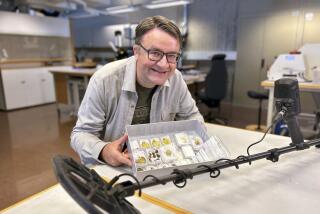Treasure hunter claims fabled find
- Share via
DEUTSCHKATHARINENBERG, GERMANY — There’s something big and metallic 60 feet below the ground in this town near the Czech border.
Whether it’s the fabled Russian Amber Room, gold or even scrap metal isn’t known. But treasure hunter Christian Hanisch hopes to snake a camera into an underground cavern to prove he has discovered Nazi plunder buried in the final weeks of World War II.
“I am sure that there is gold or silver down there,” said Hanisch, who hopes to begin drilling within days.
Hanisch was led to the spot on the fringes of Deutschkatharinenberg, about 100 yards from the Czech Republic, by a set of coordinates he found in a notebook belonging to his father, a former Luftwaffe radio operator who died last year.
He joined forces about two months ago with the town’s mayor, Hans-Peter Haustein, an amateur treasure hunter and a member of Germany’s parliament for the opposition Free Democratic Party.
A scan of the cavern with a sophisticated metal detector has shown a big rectangle in red, indicating metal, likely gold or silver, Hanisch said.
Days ago, Haustein said he was convinced they had found the Soviet Union’s storied Amber Room treasure, which he has been seeking for 12 years.
The Amber Room, completed in 1711 after a decade of work, was installed in a palace the czar built for his wife, Catherine I, outside St. Petersburg.
The 1,300-square-foot hall included a gold-framed mosaic of marble and semi-precious stones that was a gift of Prussian King Friedrich Wilhelm I to Russia’s Peter the Great. The wall panels were made of golden brown amber.
The Amber Room was moved to Koenigsberg, now the Russian city of Kaliningrad, when retreating Nazi troops looted the palace in World War II. It disappeared in 1945. Only pieces have been found.
Experts greeted the discovery claim with skepticism, noting that such stories surface regularly, only to be disproved.
More to Read
Sign up for Essential California
The most important California stories and recommendations in your inbox every morning.
You may occasionally receive promotional content from the Los Angeles Times.













